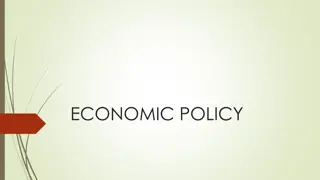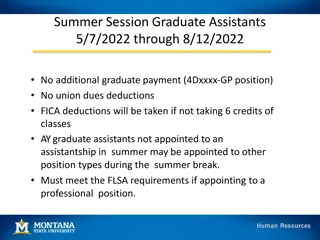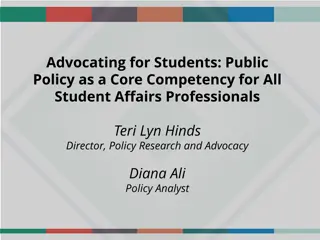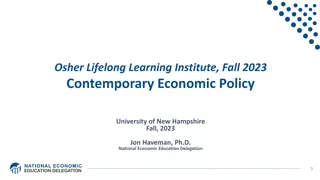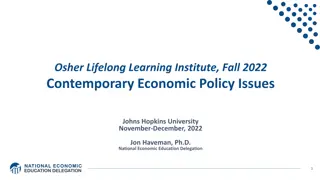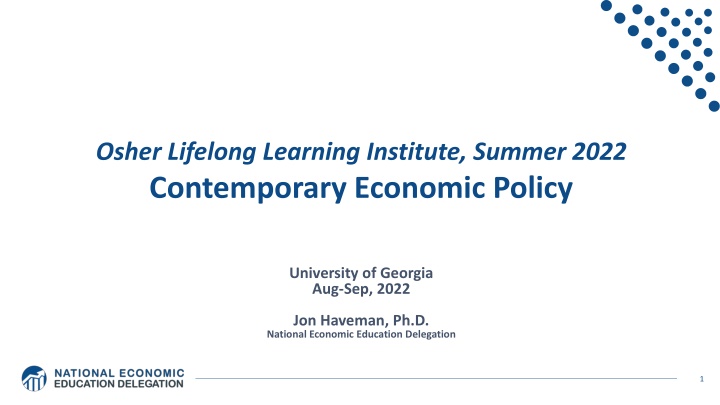
Economic Policy Insights: Summer 2022 Course Overview
Dive into Contemporary Economic Policy topics like Climate Change Economics, Immigration Economics, Economic Inequality, and Federal Debt in this insightful course outline for the Summer 2022 session at the Osher Lifelong Learning Institute, University of Georgia.
Download Presentation

Please find below an Image/Link to download the presentation.
The content on the website is provided AS IS for your information and personal use only. It may not be sold, licensed, or shared on other websites without obtaining consent from the author. If you encounter any issues during the download, it is possible that the publisher has removed the file from their server.
You are allowed to download the files provided on this website for personal or commercial use, subject to the condition that they are used lawfully. All files are the property of their respective owners.
The content on the website is provided AS IS for your information and personal use only. It may not be sold, licensed, or shared on other websites without obtaining consent from the author.
E N D
Presentation Transcript
Osher Lifelong Learning Institute, Summer 2022 Contemporary Economic Policy University of Georgia Aug-Sep, 2022 Jon Haveman, Ph.D. National Economic Education Delegation 1
Available NEED Topics Include: Coronavirus Economics Immigration Economics US Economy Housing Policy Climate Change Federal Budgets Economic Inequality Federal Debt Economic Mobility Black-White Wealth Gap Trade and Globalization Autonomous Vehicles Minimum Wages US Social Policy 2
Course Outline Contemporary Economic Policy - Week 1 (8/23): Climate Change Economics (Sarah Jacobson, Williams College) - Week 2 (8/30): Economics of Immigration (Jennifer Alix-Garcia, Oregon St. Univ.) - Week 3 (9/6): Economic Inequality (Kelley Cullen, E. Washington University) - Week 4 (9/13): Federal Debt (Brian Peterson, Central College) 3
Submitting Questions Please submit questions in the chat. - I will try to handle them as they come up, but may take them in a bunch as time permits. I will catch up on the questions in the chat before starting up again after the break. We will do a verbal Q&A once the material has been presented. - And the questions in the chat have been addressed. 4
The Economics of Immigration OLLI University of Georgia August, 2022 Jennifer Alix-Garcia, PhD 5
Outline What is immigration? Why do people migrate? History of immigration to the US Economics of immigration
What Is Immigration? Immigration - The action of coming to live in another country. Emigration - The act of leaving one s own country and going to live in another country. 7
Why Do People Migrate? Push factors: - Economic dislocation, violence, population pressures, religious persecution, or denial of political rights. Pull factors: - Potential for higher wages, job opportunities, and political or religious liberty. Uneven development: - Disparities in income, standards of living, and the availability of jobs within and across societies. 8 Source: Gilder Lehrman Institute of American History.
Why Do People Migrate? Levels of Decision-Making Individual level: - Economic opportunity, escape social turmoil. Family level: - Desire of the family to improve its security or level of economic well-being. - Remittances Structural or Institutional: - War, better information about opportunities, easier transportation, income differentials between countries. - Changes in immigration policies. 9 Source: Gilder Lehrman Institute of American History.
History of US Immigration Source Countries African countries* Pre-1790 Source Countries African countries* 1790-1820 300,000 85,000 England 300,000 Scotland-Ireland 50,000 England 45,000 Scotland-Ireland 100,000 France 40,000 Germany 100,000 Germany 25,000 Scotland 75,000 * Slave trade and clearly not voluntary or reflective of standard motivations for immigration. 10 Source: https://www.libertyellisfoundation.org/immigration-timeline/.
History of US Immigration Source Countries 1820-1880 Germany 3,000,000 Ireland 2,800,000 Britain 2,000,000 Austro- Hungarian empire 1,000,000 Canada 750,000 China 230,000 African 50,000 https://www.libertyellisfoundation.org/immigration-timeline countries 11
History of US Immigration Source Country 1880-1930 Italy 4,600,000 Austro- Hungarian empire 4,000,000 Russian empire 3,300,000 German empire 2,800,000 Britain 2,300,000 Canada 2,300,000 Ireland 1,700,000 12
History of US Immigration Source Countries 1930-1965 Germany 940,000 Canada 900,000 Mexico 610,000 Britain 480,000 Italy 390,000 Caribbean/ West Indies 310,000 13 Source: https://www.libertyellisfoundation.org/immigration-timeline/.
History of US Immigration: 1965-Today Source Country 1965-2017 Mexico 4,300,000 Philippines 1,400,000 South Korea 760,000 Dominican Republic 750,000 India 740,000 Cuba 700,000 Vietnam 700,000 Canada 650,000 15 Source: https://www.libertyellisfoundation.org/immigration-timeline/.
Authorized Immigration during the pandemic** ***These figures have been added to the NEED slide deck by the presenter. 16
Immigrant Population in 2017 Categories of the total number of immigrants in the United States. 20 https://www.pewresearch.org/fact-tank/2019/07/12/how-pew-research-center-counts-unauthorized-immigrants-in-us/
U.S. Unauthorized Immigration Totals 21 Pew Research Center, 5 facts about illegal immigration in the U.S., June 12, 2019
Unauthorized Immigration: Education 23 Pew Research Center, U.S. unauthorized immigrants are more proficient in English, more educated than a decade ago, May 23, 2019
Why Do We Care? Economic Implications GDP Labor markets Government revenue and spending Prices Exports and FDI 25
Two Sets of Implications Aggregate effects: The size of the pie Income distribution: The size of slices of the pie 26
GDP: How Does This Work? What determines the size of an economy? - Technology/productivity - Physical capital - The number of workers o Immigration adds to the number of workers. Number of immigrants in the labor force is high - 28.2 million foreign-born persons ages 16+ in the labor force in 2018. - 17.4% of the total US workforce. Evidence - Immigrants added 11% to GDP ($2 trillion) in 2016. 27
Labor Market Implications: Complicated Depends on the type of immigrant: Skills/education - Similar to native-born population? - Low-skilled? - Highly skilled? Brings capital market implications - Low-skilled capital supplementing - Highly skilled capital complementing 29 Source: Hong & McLaren (2015).
Labor Market Implications Provides net benefits to the receiving economy - Larger labor supply. - Changes in labor prices increase production of goods and services that use the type of labor offered by immigrants. Short run: there are winners and losers - Changes in wage structure and returns to capital affect native-born workers differently depending upon skill level. Long run: could be no winners, but also no losers - The economy might adjust to pre-immigration wage structure and returns to capital. No change for native-born individuals. 30
Summary of Labor Market Effects Immigration CAN lead to negative wage effects for competing native-born workers in the short run - Particularly high school dropouts and those in vulnerable communities. Other workers will likely benefit - Through increased wages. - Through increased opportunity (each immigrant creates ~1.2 local jobs). Owners of capital will benefit - Existing capital will earn greater returns. - More if immigrant labor complements existing capital. 31 Source: Hong & McLaren (2015).
Pattern of Immigration Educational Attainment of Recent Immigrants Last 5 Years 32 Source: Blau & Mackie (2017), p. 88.
Skilled Immigrants and Innovation 1% increase in the share of the immigrant college graduate population - 9-18% increase in patenting per capita - Increased immigration increases patenting by native-born population - Nonetheless, the effect is positive In the 1990s - Increased skilled immigration can account for one-third of increased patenting in that decade. - This translates into a 1.4-2.5% increase in GDP per capita by the end of the decade. 34
Immigrants and Entrepreneurship Self-Employment Rates by Nativity 35 Source: Magnus Lofstrom from Current Population Survey Data.
Fortune 500: First- and Second-Generation Founders 37
Immigration and Prices How do immigrants lower prices? - Demand side o A higher proportion of immigrants tends to make markets more price sensitive. o Accordingly, stores are reluctant to raise prices. - Supply side o By providing labor services at lower cost. o Input prices are lowered, so final goods prices are also likely to be lower. o Primarily in nontraded sectors Household services, construction, hospitality, agriculture. 38
Prices: Distributional Consequences A 10% increase in the share of low-skilled immigrants in a city: - Lowers prices of immigrant-intensive sectors by 2%. o E.g., housekeeping, gardening, babysitting, dry cleaning Immigration between 1980 and 2000 immigration affected the cost of living: - -0.32% for highly skilled workers but not for everybody: - +1% for native high school dropouts - +4.2% for low-skilled native-born Hispanics Conclusion: - Positive net benefits for the country as a whole. - But not all benefit. 39 Cortes (2008)
Prices and Economic Expansion Economic Expansion - Increases the labor supply. o Lowers the prices of immigration-intensive products. - Frees up highly skilled labor to provide more market services. o Primarily through provision of household services. o Evidence of an expansion of labor provided by highly skilled women. Particularly where long hours are required: law, medicine, and women with PhDs 40 Source: Cortes & Tesada (2011).
Government Revenues and Expenditures 41
Why Is This Important? Important factor for understanding whether immigrants will be net contributors to the economy. Two additional reasons: - Taxpayer inequity geographically - Necessary to understand the full consequences of admitting additional immigrants into the country 42
Topics? Basic Question: - Taxes (income, sales, and other) immigrants pay vs. government expenditures on public benefits and services they receive. More complicated: - Immigrants also affect the fiscal equation for many native-born residents. o Indirectly through labor and capital markets. o Changes in wages and the return to capital. 43
Age-Specific Taxes and Benefits By Immigrant Generation, United States, 2012 44 Source: Blau & Mackie (2017), p. 325.
What Do We Know? Immigrants who arrive while of working age: - Are, on average, net contributors. - 21-year-old with a high school diploma: +$126,000 over a lifetime o Though this value gradually declines with age at arrival. o Turns negative for arrivals of age 35+ Net contribution crucially depends on characteristics - Age distribution, family composition, health status, fertility patterns - Temporary or permanent relocation - Employment in the legal labor market - Authorized or unauthorized 45
Bottom Line/Consensus of Estimates Federal level: fiscal impact is generally positive. State and local level: typically negative fiscal impact. 46
Implications for Major Federal Programs Documented immigrants are less likely to use Social Security and Medicare. Unauthorized immigrants are ineligible. - They will pay into the system but cannot receive benefits. Medicaid: not available to legal residents for the first five years. Provide a source of revenue for an aging population. 47
The Aging US Population 48 Source: Blau & Mackie (2017), p. 63.
Implications for Social Security Population Age 65+ per 100 of Working Age (25-64) 49 Source: Blau & Mackie (2017).
Other Implications of Immigration 50














